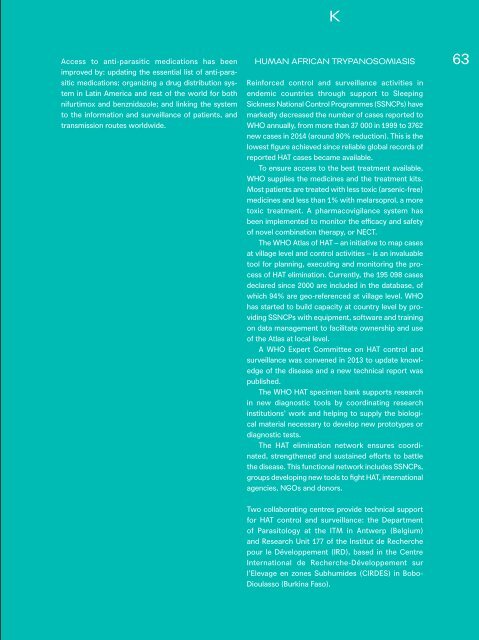Create successful ePaper yourself
Turn your PDF publications into a flip-book with our unique Google optimized e-Paper software.
K<br />
Access to anti-parasitic medications has been<br />
improved by: updating the essential list of anti-parasitic<br />
medications; organizing a drug distribution system<br />
in Latin America and rest of the world for both<br />
nifurtimox and benznidazole; and linking the system<br />
to the information and surveillance of patients, and<br />
transmission routes worldwide.<br />
HUMAN AFRICAN TRYPANOSOMIASIS<br />
Reinforced control and surveillance activities in<br />
endemic countries through support to Sleeping<br />
Sickness National Control Programmes (SSNCPs) have<br />
markedly decreased the number of cases reported to<br />
WHO annually, from more than 37 000 in 1999 to 3762<br />
new cases in 2014 (around 90% reduction). This is the<br />
lowest figure achieved since reliable global records of<br />
reported HAT cases became available.<br />
To ensure access to the best treatment available,<br />
WHO supplies the medicines and the treatment kits.<br />
Most patients are treated with less toxic (arsenic-free)<br />
medicines and less than 1% with melarsoprol, a more<br />
toxic treatment. A pharmacovigilance system has<br />
been implemented to monitor the efficacy and safety<br />
of novel combination therapy, or NECT.<br />
The WHO Atlas of HAT – an initiative to map cases<br />
at village level and control activities – is an invaluable<br />
tool for planning, executing and monitoring the process<br />
of HAT elimination. Currently, the 195 098 cases<br />
declared since 2000 are included in the database, of<br />
which 94% are geo-referenced at village level. WHO<br />
has started to build capacity at country level by providing<br />
SSNCPs with equipment, software and training<br />
on data management to facilitate ownership and use<br />
of the Atlas at local level.<br />
A WHO Expert Committee on HAT control and<br />
surveillance was convened in 2013 to update knowledge<br />
of the disease and a new technical report was<br />
published.<br />
The WHO HAT specimen bank supports research<br />
in new diagnostic tools by coordinating research<br />
institutions’ work and helping to supply the biological<br />
material necessary to develop new prototypes or<br />
diagnostic tests.<br />
The HAT elimination network ensures coordinated,<br />
strengthened and sustained efforts to battle<br />
the disease. This functional network includes SSNCPs,<br />
groups developing new tools to fight HAT, international<br />
agencies, NGOs and donors.<br />
63<br />
Two collaborating centres provide technical support<br />
for HAT control and surveillance: the Department<br />
of Parasitology at the ITM in Antwerp (Belgium)<br />
and Research Unit 177 of the Institut de Recherche<br />
pour le Développement (IRD), based in the Centre<br />
International de Recherche-Développement sur<br />
l’Elevage en zones Subhumides (CIRDES) in Bobo-<br />
Dioulasso (Burkina Faso).


